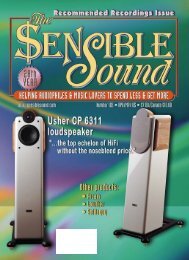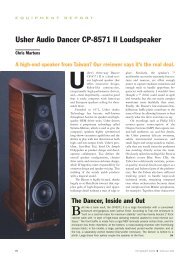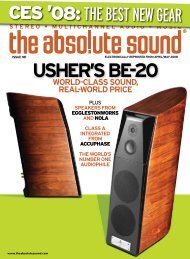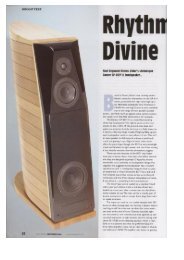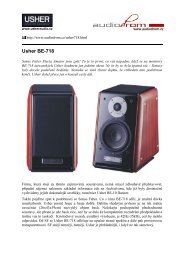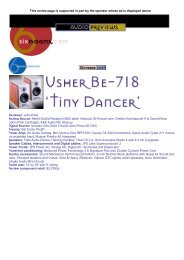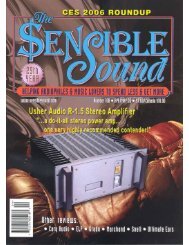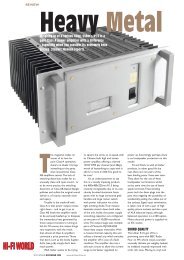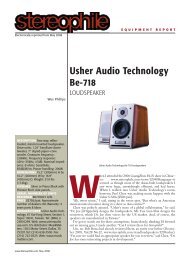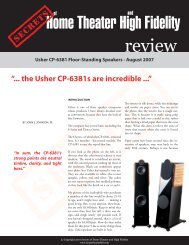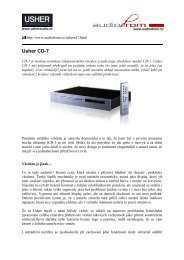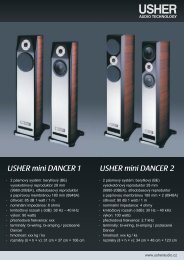22USHER V-602, TEST v SoundStage 2007 - USHER Audio ...
22USHER V-602, TEST v SoundStage 2007 - USHER Audio ...
22USHER V-602, TEST v SoundStage 2007 - USHER Audio ...
You also want an ePaper? Increase the reach of your titles
YUMPU automatically turns print PDFs into web optimized ePapers that Google loves.
June 1, <strong>2007</strong><br />
Usher <strong>Audio</strong> Technology V-<strong>602</strong> Loudspeakers<br />
Because I publish the <strong>SoundStage</strong>! Network, many people assume that I<br />
always review the priciest stuff -- it should go with the territory, they seem<br />
to think. But while I do review costly gear from time to time, my interest is<br />
mainly in what’s called "affordable" equipment -- stuff the average person<br />
can buy. There are two reasons for this. First, I’m more interested in<br />
products whose performance meets or exceeds the asking price -- a<br />
criterion that the pricey stuff meets only rarely. Second, far more shoppers<br />
can afford this kind of equipment, so reviews of such components are<br />
relevant and useful to many more people.<br />
Enter Usher <strong>Audio</strong> Technology’s V-<strong>602</strong>, an impressive loudspeaker that I<br />
thought, when I received the review samples, probably sold for at least<br />
$1500/pair USD -- itself an affordable price, and not a bad deal at all. A<br />
little way into the review, I learned that they cost just $1040 per pair.<br />
Description<br />
Usher <strong>Audio</strong> is based in Taiwan, but they get some important help from<br />
well-known US-based speaker designer Dr. Joseph D’Appolito. Yes, that<br />
Dr. D’Appolito -- of the D’Appolito configuration and all. Suffice it to say that<br />
Dr. D’Appolito knows his way around a loudspeaker; my understanding is<br />
that his input is crucial for all Usher speakers, particularly in the design of<br />
the crossovers.<br />
The manufacturing, however, is all done in Taiwan, in Usher’s own factory.<br />
In fact, Usher even makes their own drivers; in the V-<strong>602</strong> at least, the<br />
drivers have a distinctly Scan-Speak-ish look.<br />
The V-<strong>602</strong> is the middle child in Usher’s new V family; below it is the V-601 ($700/pair), above it the V-604 ($1480/pair). There’s<br />
also a center-channel model, the V-603 ($620). All Usher Vs use the same drive-units and feature the same kind of cabinet<br />
construction and build quality. The main differences are in size, number of drivers, and crossover. For example, the V-601 and V-<br />
<strong>602</strong> share the same driver complement, but the V-601, a small bookshelf speaker, requires a stand, while the V-<strong>602</strong> is a<br />
floorstander of moderate size. The floorstanding V-604 has two mid-woofers and a slightly larger cabinet.<br />
The V-<strong>602</strong> measures 40"H x 13"W x 11.5"D and weighs about 53 pounds. The cabinet is said to be made of 1"-thick MDF<br />
throughout; some hard raps with my knuckles here and there revealed it to be sturdily built. More impressive are the real-wood<br />
veneers of Mahogany Cherry and Golden Cherry -- one of the reasons I thought the V-<strong>602</strong> cost a lot more than it does. You don’t<br />
always get real-wood finish of this quality in a floorstander of this size at this price; usually, you get vinyl. But this is just one of the<br />
areas in which the V-<strong>602</strong> delivers more than its price tag lets on. Usher evidently has its manufacturing down.
The styling is only so-so, to my eyes. Usher dresses up the V-<strong>602</strong> a bit with beveled front edges and a bottom plinth painted black<br />
for contrast, but all in all, the V-<strong>602</strong> looks a bit yesteryear. However, I can’t knock the speaker too much for that. There are plenty<br />
of sharp-looking speakers these days -- usually made of aluminum, but some are actually plastic -- that sound dreadful. The V-<strong>602</strong><br />
isn’t one of them.<br />
The V-<strong>602</strong>’s tweeter is Usher’s 9930-20NC model, a 1" soft dome. The 7" mid-woofer (model 8935A) appears to be a cone of<br />
treated paper. The tweeter and mid-woofer hand off to each other at 2.2kHz, a lowish figure that likely helps make for a smooth<br />
transition both on and off axis. The V-<strong>602</strong>’s sensitivity is said to be 87dB/W/m, its impedance 8 ohms -- a "normal" load for any<br />
amplifier. You can biwire the V-<strong>602</strong> if you wish; I single-wired them. A slot port on the front helps extend the speaker’s bass<br />
response, which Usher rates at 38Hz, -3dB -- if accurate, that’s low enough that most music lovers won’t be itchin’ to mix in a<br />
subwoofer.<br />
Nothing in the V-<strong>602</strong>’s specs is extraordinary; in fact, they’re somewhat ordinary. Still, their very ordinariness is somewhat<br />
extraordinary -- all too often these days, manufacturers push the envelope of credibility with their claimed specifications, in hopes<br />
that no one will examine them too closely. Here at <strong>SoundStage</strong>!, we do check many products through our measurement process,<br />
to weed out who’s telling the truth from who’s not. However, even without measurements, just based on common sense and<br />
experience, the specs supplied by Usher for the V-<strong>602</strong> seem credible, something I commend.<br />
System<br />
I drove the Usher V-<strong>602</strong>s with Simaudio’s extraordinary Moon Evolution i-7 integrated amplifier, which is rated at 150Wpc. This<br />
was way more power than these speakers need, but I like using the i-7 for its neutrality -- it has no apparent character of its own,<br />
so I know exactly what the speakers are doing and what they aren’t. However, I also tried Zanden <strong>Audio</strong>’s Model 600, a 30Wpc<br />
tube amp, just to give the Ushers a go not only with less power, but with tubes, too, which added a bit more character to the<br />
sound. As you’ll read below, the results were interesting, and important for prospective buyers.<br />
The digital front end was my Theta Data Basic transport feeding a Stello DA220 DAC via an i2Digital X-60 digital interconnect.<br />
Analog interconnects from the Stello to the Simaudio i-7 were Nordost Quattro Fil, and Nirvana S-L speaker cables connected the<br />
7 to the Ushers.<br />
To get as good an idea as I could of how the Ushers would perform alone, I minimized the effects of my room by placing the<br />
speakers way out in the listening area: 8’ from the front wall, 5’ from the sidewalls, and 7’ apart. The angle of toe-in was a modest<br />
10 degrees.<br />
Sound<br />
The V-<strong>602</strong>s entered my review queue right after the Mirage OM Design OMD-28 -- a tough act to follow. The OMD-28 is so good<br />
that I consider it an extremely good deal even for $7500/pair -- that’s from me, the guy who likes "affordable" stuff. After such an<br />
experience, no one would expect much from a pair of speakers costing only a seventh as much.<br />
But the V-<strong>602</strong>s didn’t embarrass themselves when they arrived center stage. I was surprised at their level of refinement, and quite<br />
bowled over by their range -- the weight and heft in the bass was thoroughly impressive for a smallish two-way floorstander. They<br />
seemed to reach down to 35-40Hz with no effort at all, and no real exaggeration or bloat. For a speaker of moderate size, the V-<br />
<strong>602</strong> sounded quite big.<br />
The pair of them could also play quite loudly, amply filling my extra-large listening room. However, that wasn’t really their forte;<br />
they cried uncle when I cranked them up to what I call "beyond normal," where my ears feel a bit uncomfortable and I know that<br />
permanent hearing damage might occur if I listened for a long time. Then they began to sound hard and distressed. Below that<br />
level, they held out just fine.<br />
What I found particularly striking was how well balanced the V-<strong>602</strong> seemed from top to bottom, and how refined and open it<br />
sounded from the mids through the highs. It didn’t sound like an entry-level speaker at all -- the other reason I’d thought it cost<br />
more at first. The V-<strong>602</strong>’s overall sound, like its build quality, seems to compete against that of speakers priced higher.<br />
For example, for the last little while I’ve been listening to The Wailin’ Jennys’ Firecracker [CD, Red House RHR195], which editor<br />
-chief Marc Mickelson put me on to. The album is well recorded, open and airy, with natural-sounding female vocals -- it doesn’t<br />
sound artificial or electronic, and it’s not overproduced. The V-<strong>602</strong> had a "quickness" to its sound that I found commendable -- it<br />
resulted in excellent transparency and detail, something you don’t often get for a mere grand. Furthermore, the speaker’s level of<br />
resolution was impressive -- its ability to bring out small details was also notable for the price.<br />
The V-<strong>602</strong>s’ highs, too, were clean and refined, going hard and edgy only when I pushed them to play too loudly. There was no<br />
rolloff in the upper frequencies to make the speaker more forgiving of source material or other ancillary equipment, as I’ve heard
from other inexpensive designs. As well, there was no depression in the upper midrange, another common trick to make a<br />
speaker sound more "relaxed."<br />
rom top to bottom, the V-<strong>602</strong> was quite revealing; if any of your upstream components have a hard, bright, or edgy sound, the V<br />
<strong>602</strong> will more than likely pass that quality along to you. In fact, the V-<strong>602</strong>’s sound was rather colorless -- in a good way. Basically,<br />
it played back what I fed it, with little signature of its own.<br />
However, that almost colorless sound had a flip side. The V-<strong>602</strong>’s neutral character resulted in a sound that I’m sure some will find<br />
a tad lean, particularly through the midrange. Voices were clear, but not overly warm and fleshed out. I can see someone not<br />
liking them who prefers a somewhat warm, rich sound to one that’s absolutely accurate. Furthermore, the lack of richness in the<br />
mids, coupled with the quite extended highs, meant that certain upper-mid shhhhh sounds were somewhat exaggerated and<br />
sibilants a bit emphasized, though this was more apparent with female than male voices. Bruce Cockburn’s robust vocal on<br />
"Ribbon of Darkness," from Beautiful: A Tribute to Gordon Lightfoot [CD, NorthernBlues Music BCDNBM500], for example,<br />
sounded just right. On the other hand, Connie Kaldor’s cover of "If You Could Read My Mind" on the same disc did exhibit those<br />
traits. So if someone listened to the V-<strong>602</strong>s and said, "there’s a hint of wispiness there," I’d have to agree. That, to my ears, is<br />
their only downside. But it’s not something I hold too strongly against them -- you can’t expect everything from a speaker costing<br />
not much more than $1000/pair. Besides, the V-<strong>602</strong> did so many things right.<br />
’ve found that many affordable speakers have presentations that are flat as a pancake, devoid of image specificity and depth. But<br />
when I pulled out my ol’ soundstaging-and-imaging standby, Ani DiFranco’s Up Up Up Up Up Up [CD, Righteous Babe RBR013-<br />
D], to see how far the V-<strong>602</strong>s could go in getting things right, the depth they portrayed was quite commendable. However, it was<br />
that stage’s width that I found remarkable. Whereas many speakers, whether low- or high-priced, draw enough attention to<br />
themselves at the outermost portion of the stage that you can confidently say, with your eyes closed, "The edges of the speakers<br />
are there and there," the V-<strong>602</strong>s "disappeared" to the point that, when I closed my eyes, the stage’s left and right boundaries<br />
weren’t marked by stark aural lines. Rather, the edges were vague, the stage often extending a little bit beyond each speaker’s<br />
outer edge, to result in a first-rate stereo spread.<br />
Within that stage, focus and precision were extremely good, with well-defined areas for each performer and no image smear to<br />
either side. One track I always check out for a test of specificity is DiFranco’s "Everest," from Up Up Up Up Up Up: her voice is<br />
placed far left in the stage and a little behind the plane of the speaker baffles. Through lesser speakers the placement isn’t<br />
precise, the depth is hard to perceive, and the voice is often smeared toward the left speaker, ruining the illusion of a singer<br />
standing there in three-dimensional space. While I can’t say that the V-<strong>602</strong>s were the very best I’ve heard at placement and<br />
precision -- that nod goes to the ultra-expensive YG Acoustics Anat Reference Main Module ($28,000/pair) -- they were as good<br />
as anything else in placing DiFranco’s voice solidly in space.<br />
I never expected such performance from a $1040 pair of speakers. Some will say this must have had a lot to do with the speakers’<br />
placement in my room, and they’re right -- speaker positioning did play a large role. But it also has to do with driver integration and<br />
how good a speaker is at getting the sound "out of the box." The V-<strong>602</strong> shot the sound out freely, in the process performing a<br />
convincing disappearing act.<br />
I also drove the V-<strong>602</strong>s with Zanden’s Model 600 tube amp. Although this amp delivers only 30Wpc compared with the Simaudio<br />
Moon Evolution i-7’s 150Wpc, I quickly learned that the V-<strong>602</strong> didn’t need an endless supply of power to sound good. The Model<br />
600’s comparatively meager output was more than enough to get the Ushers to high enough listening levels, and there was still<br />
very good bass. Furthermore, I heard some improvement in the midrange and highs. Whereas the i-7 is dead-neutral and<br />
ultraprecise -- which was one of the ways I could tell that the V-<strong>602</strong> was a touch lean -- the Zanden 600 lets a little more color into<br />
the sound, bolstering the "presence" in the midrange region and sweetening the highs. This didn’t completely eliminate the V-<br />
<strong>602</strong>’s leanness in the mids, but it did add some richness and fullness there. The highs, too, weren’t quite as airy as with the Moon<br />
7, but they had a bit more sweetness, something I’m sure many will like. I attribute these sonic changes mostly to the sound of<br />
the Zanden 600. As I’ve said, the V-<strong>602</strong> did a very good job of putting out what I fed it.<br />
Comparison<br />
Four years ago, I reviewed Von Schweikert’s VR-1 bookshelf speaker. The VR-1 made a splash by offering good sound and realwood<br />
veneer, a combo not that easy to find back then for $995/pair. As a result, the VR-1 was considered a very good value, and<br />
received our Reviewers’ Choice nod. It remains available today for the same price.<br />
But times have changed, and even at the same price, the VR-1 isn’t quite the deal it once was. Today you can find plenty of<br />
affordable bookshelf speakers with real-wood veneers -- Usher’s own V-601 costs just $700/pair. Furthermore, if you don’t put<br />
bookshelf speakers on a shelf, then you’ll need stands, which is what most audiophiles who are serious about getting the best<br />
performance do anyway. Depending on what stands you buy, they can set you back hundreds of dollars.
Usher’s V-<strong>602</strong> needs no stands, has a high-quality, real-wood veneer on a much bigger cabinet<br />
than the VR-1’s, and, to my ears, sounds better overall. The VR-1 sounds pretty grand for a small<br />
speaker, and has more than a hint of the richness in the mids that the V-<strong>602</strong> lacks, but the Usher<br />
goes deeper in the bass and sounds more balanced through the mids and highs. The V-<strong>602</strong>’s<br />
resolution, too, is superior, and a pair of them throws a wider soundstage with greater image<br />
specificity. All in all, the V-<strong>602</strong> is a better speaker and a far better value.<br />
Conclusion<br />
I often come across very expensive floorstanding two-way loudspeakers of a size and driver<br />
complement similar to those of the Usher V-<strong>602</strong>, but at prices far, far higher. At such times, my<br />
question is always, "What makes you special enough to warrant such an asking price" Sometimes<br />
there’s a reason; often there’s not.<br />
Looking at the V-<strong>602</strong>, it’s not hard to see what makes this speaker special and easy to recommend.<br />
Its build quality, which is outstanding for the price, is on a par with its sound. And the V-<strong>602</strong>’s shortfalls -- its somewhat dated<br />
styling, its leanness through the mids -- are minor compared to the areas where it exceeds. As I said, when the review samples<br />
were delivered, I thought the V-<strong>602</strong> cost at least $1500/pair -- and that sounded reasonable. At $1040/pair, however, the rules are<br />
different. There’s no question that the V-<strong>602</strong> from Usher <strong>Audio</strong> Technology is one of those loudspeakers that can be considered<br />
something of a steal.<br />
…Doug Schneider



